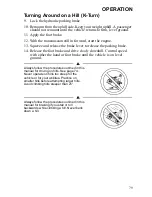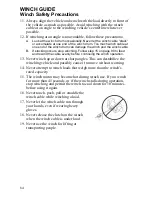
71
OPERATION
Driving Through Water
Follow these procedures when
driving through water:
1. Check water depth and
current before crossing.
2. Choose a crossing where
both banks have gradual
inclines.
3. Drive slowly. Avoid rocks
and obstacles.
4. Avoid operating in water
deeper than the bottom of
the footrests. If it’s
unavoidable, travel slowly,
balance your weight carefully and avoid sudden movements.
Maintain a slow and steady forward motion. Do not make sudden
turns, stops or throttle changes.
NOTICE:
If the vehicle stops while fully submerged, major engine damage can
result if the machine is not thoroughly inspected. Take the vehicle to
your dealer before starting the engine.
5. Wet brakes may have reduced stopping ability. Dry the brake pads
by driving slowly and applying the brakes lightly several times until
braking action is normal.
6. If your vehicle becomes fully immersed, and it’s impossible to take
it to a dealer before starting it, follow the steps described on page
127. Have the vehicle serviced by your dealer promptly.
Always follow the procedures outlined in this
manual for driving through water. Never drive
through deep or fast-flowing water.
Maximum
Depth
















































